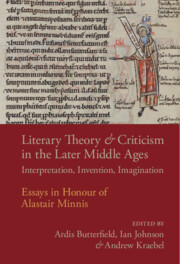Book contents
- Literary Theory and Criticism in the Later Middle Ages
- Literary Theory and Criticism in the Later Middle Ages
- Copyright page
- Contents
- Figures
- Contributors
- Preface and Acknowledgements
- Abbreviations and Conventions
- The Career and Contributions of Alastair Minnis
- Introduction
- Chapter 1 Access through Accessus
- Chapter 2 Scholastic Theory and Vernacular Knowledge
- Chapter 3 Poetics and Biblical Hermeneutics in the Thirteenth Century
- Chapter 4 Robert Holcot and De vetula
- Chapter 5 The Inspired Commentator
- Chapter 6 Guitar Lessons at Blackfriars
- Chapter 7 The Re-cognition of Doctrinal Discourse and Scholastic Literary Theory
- Chapter 8 Arts of Love and Justice
- Chapter 9 The Many Sides of Personification
- Chapter 10 Encountering Vision
- Chapter 11 George Colvile’s Translation of the Consolation of Philosophy
- Chapter 12 When Did the Emotions Become Political?
- Bibliography of the Works of Alastair Minnis
- Bibliography
- Index
Chapter 9 - The Many Sides of Personification
Rhetorical Theory and Piers Plowman
Published online by Cambridge University Press: 20 April 2023
- Literary Theory and Criticism in the Later Middle Ages
- Literary Theory and Criticism in the Later Middle Ages
- Copyright page
- Contents
- Figures
- Contributors
- Preface and Acknowledgements
- Abbreviations and Conventions
- The Career and Contributions of Alastair Minnis
- Introduction
- Chapter 1 Access through Accessus
- Chapter 2 Scholastic Theory and Vernacular Knowledge
- Chapter 3 Poetics and Biblical Hermeneutics in the Thirteenth Century
- Chapter 4 Robert Holcot and De vetula
- Chapter 5 The Inspired Commentator
- Chapter 6 Guitar Lessons at Blackfriars
- Chapter 7 The Re-cognition of Doctrinal Discourse and Scholastic Literary Theory
- Chapter 8 Arts of Love and Justice
- Chapter 9 The Many Sides of Personification
- Chapter 10 Encountering Vision
- Chapter 11 George Colvile’s Translation of the Consolation of Philosophy
- Chapter 12 When Did the Emotions Become Political?
- Bibliography of the Works of Alastair Minnis
- Bibliography
- Index
Summary
Classical and medieval rhetorical theorists had many names for the figure of thought that we call ‘personification’ or prosopopoeia. This fundamentally hybrid figure occurs at the confluence of different kinds of discourse; definitions range across a spectrum from the ‘animate abstraction’ to the ‘person introduced to speak’. The essay explores the diverse rhetorical theory behind this figure. It then discusses the hybridity of this figure, and in particular its striking capacity for multivalency, change and even disintegration (paradiastole), in medieval vernacular narrative allegory. It focuses on Langland’s Piers Plowman, with reference to the figures Clergie, Patience, Conscience, Wil, Haukyn and Piers Plowman. Finally, the essay investigates another aspect of this hybridity that might seem counter-intuitive to readers who assume that prosopopoiae/personifications should have surface or even naturalistic narrative coherence: the way that this figure of thought allows Langland repeatedly to cultivate an ambiguity about whether his prosopopoiae/personifications are lay or ordained. This telling ambiguity reflects the poet’s disengaged attitude to the institution of the church and even the priesthood.
Keywords
- Type
- Chapter
- Information
- Literary Theory and Criticism in the Later Middle AgesInterpretation, Invention, Imagination, pp. 180 - 205Publisher: Cambridge University PressPrint publication year: 2023
- 1
- Cited by

